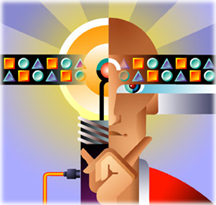 |
The Interactive Performance of SLIM:
|
|
Introduction by J. Duane Northcutt This paper provides results from work that began as a Sun Labs research project (named NewT), evolved into a product development project (known as Corona), and finally resulted in the Sun Ray(TM) product. This was the last in a series of research projects by a group that was formed when Sun Labs was founded and spanned the Lab's first decade. This group's preceding projects included: HDTV Workstation, OS and Network Support for Digital Audio and Video, Video over ATM, High-Speed Networking with ATM, Dynamic Auctioning of Network Bandwidth, Microeconomic Models of System-Level Resource Management, SunTuner, TV Datacasting, Sun Media Center, Java Media APIs, and NetCam. The key observation behind this work is that new trade-offs between computation and communication are enabled by the fact that bandwidth is rapidly becoming less expensive and more abundant. This paper shows how it is possible to create low-cost, fixed-function devices that can deliver a high-end multimedia workstation experience, while simultaneously avoiding the usual demand for upgrades as application resource requirements increase. Based on the concepts put forth in this paper, Sun Ray(TM) became the first (and to date, the only) technically and economically viable "thin client" product. The NewT project was an attempt to explore the limits of how thin a client could be made without compromising the user experience, even as applications evolve in unanticipated ways. Work prior to this has primarily been focused on the "stripped-down PC" approach to thin clients, which attempted to lower costs by restricting functionality. Sun Ray is different from all types of thin clients in that it does no computation locally and retains no (hard) state locally. This work established that no stable architectural point exists between the traditional PC (where all computation and state is local), and the fixed function Sun-Ray-like device (where all computation and state exists remote from the client). This research project led to the creation of a business unit (the Information Appliances Group) and influenced a wide variety of other groups within Sun. It provided the newly-formed education group with a product to suit its market needs, and also provided the desktop group with an alternative client device for the low end of its markets. In addition, the Information Appliances Group acquired StarDivision in order to obtain a Solaris-based office application suite (StarOffice(TM)) that would meet the needs of targeted Sun Ray markets. The Sun Ray product was built by a small group, in an extremely short period of time, at an exceptionally low development cost. The initial product development (both hardware and software), and the initial internal deployment, were done entirely with the NewT prototypes created in Sun Labs, and a single (eight CPU) multiprocessor server. The Sun Ray product would not have been possible without Sun Labs. It provided the environment that made the genesis of the idea possible, as well as the resources and support to allow the concept to be made real and properly explored. Even well after the product introduction, there were many assertions that Sun Ray was not possible, and so it seems quite likely that the product would never have have gotten past the viewgraph stage were it not for the incubating function provided by the leadership of Sun Labs.
|
|
|
Last changes:
Saturday, February 10, 2007 04:17:32 AM,
:P 2004-2005 filibeto.org, site statistics, legal stuff |
